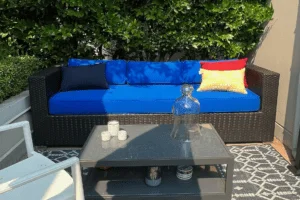To Welt or Not to Welt: A Guide to Cushion Design
If you’re in the market for new cushions or designing your own, you may have come across the term “welting” or “piping.” What is it, and do you need it? In this post, we’ll explore the benefits and drawbacks of cushion welting.
What is Welting?
Welting, or piping, is an extra tube of fabric that is sewn into the seam of a cushion. It can be made from the same fabric as the cushion or a contrasting fabric, and it can be flat or corded.
Flat welting uses only the fabric of the cushion, where corded piping includes a cord or ‘pipe’ that additional fabric is sewn around.
The default type of piping at Northern Patio is corded, and flat welting requires a conversation with the manufacturer.
Piping is often used for decorative purposes, but it can also provide structural support to the cushion.

Sofa in Tempotest’s Unite Prussian Blue with welting, 5 inch seats and 4 in backs (comfort fill)
Aesthetics
One of the most obvious benefits of welting is its aesthetic appeal. It gives cushions clean lines and a classic look that can complement a variety of design styles.
If you’re going for a more traditional or formal look, piping is a great choice. However, if you’re going for a more modern or minimalist look, welting may not be necessary.
Structural Support
Piping can also provide structural support for a cushion. By adding tension and firmness to the seams, welting can help cushions keep their shape over time. This is especially important for cushions that will be used frequently or for long periods of time.
Bench cushions that are long and thin can be reinforced against warping with piping, ensuring that the cushion keeps its shape with use.
If a cushion is very large, piping is not necessary for structural support, though it can still provide that benefit.
Piping can also reinforce the seams to reduce wearing over time.
Welting Drawbacks
While welting can provide both aesthetic and structural benefits, there are also some drawbacks to consider.
For one, piping is more expensive than a plain cushion due to the extra fabric and labour required. Additionally, welting may not be necessary for all cushions.
If you’re on a tight budget or going for a more casual look, piping may not be worth the extra cost.
Conclusion
In the end, whether or not to welt your cushions comes down to personal preference and the specific needs of your cushions. If you’re looking for a classic, formal look or need extra structural support, piping is a great choice. However, if you’re on a budget or going for a more casual look, welting may not be necessary.
Remember that cushion design is about more than just piping. Consider factors such as fabric choice, colour, and size when designing your cushions. With the right design choices, your cushions can be both beautiful and functional.


 Contact Northern Patio
Contact Northern Patio